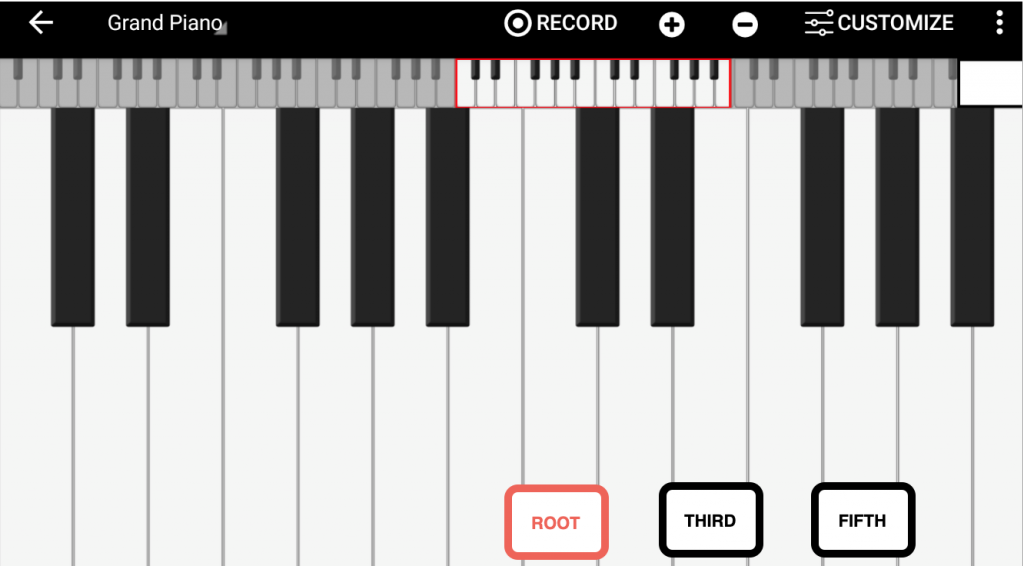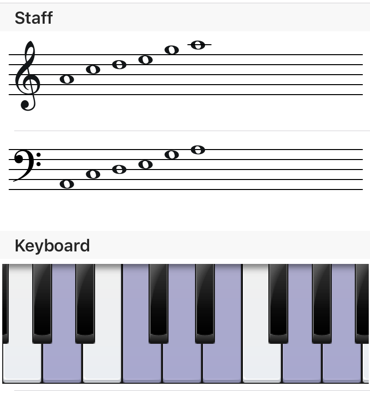A piano chord is one of the main building-blocks of music in western culture. Along with scales and intervals, piano chords are responsible for the creation of cohesion and structure in essentially every song and piece of music.
A piano chord can also be defined as a collection of notes in a predetermined type of ordering. This ordering is based on the idea of stacking two notes over a root at a determined interval (distance) called a third. The three notes that make up a piano chord are respectively called root, third, and fifth due to the order in which they appear. A simple approach to playing your first piano chord would be to visualize them as a simple but abstract three-note structure that can be imposed over the white keys of the keyboard. Basically, an initial note then skips one key, press that one, and repeat the previous step.
Musical intervals and piano chord
To be able to learn to quickly construct piano chords, we should first examine their most fundamental building blocks, the aforementioned intervals. A musical interval is the measure of the distance between any two given pitches within a reference system. A good way of understanding intervals is through the use of the smallest possible distance between two distinct notes, the half step. This method to measure distance can be exemplified by playing any key of the keyboard and then playing the most immediate key over or under it. For example, C and C# or C and B. It should also be noted that our tuning system only contains twelve distinct pitches, meaning that after 12 half steps the system repeats itself with the last note carrying the same name as the initial one.
These intervals are then categorized in a series of numbers directly correlated to the number of half steps and keys implied.
| Interval Name | Amount of Half Steps |
|---|---|
| Minor second | 1 |
| Major second | 2 |
| Minor third | 3 |
| Major third | 4 |
| Perfect fourth | 5 |
| Augmented fourth | 6 |
| Perfect fifth | 7 |
| Minor sixth | 8 |
| Major sixth | 9 |
| Minor seventh | 10 |
| Major seventh | 11 |
| Perfect octave | 12 |
Types of piano chords
Triadic piano chords are the most simple and common types of chords we can find in music. These are essentially small collections of three notes which follow a certain ordering of third intervals within a scalar reference system.
Western tonal music and its particular tuning system produce only four distinct types of triads. Namely, major, minor, diminished, and augmented. On top of having a radically different sound and emotional properties, these chordal structures are differentiated from each other by the ordering and quality of the intervals between its constituent factors. These intervals are always thirds, both major and minor. The order in which they appear will determine the quality of the piano chord at hand. These are exemplified in the table below:
| Type of chord | Quality and order of thirds* | Amount of half steps and total intervallic content |
|---|---|---|
| Major | M3+m3 | 4+3=7 |
| Minor | M3+M3 | 3+4=7 |
| Diminished | M3+m3 | 3+3=6 |
| Augmented | M3+M3 | 4+4=8 |
*Where “M3” is the major third and “m3” is a minor third.
Like most things in music, like rhythm, form, or dynamics, chord types aren’t absolute and isolated objects. They are a product of the distance relationships between its constituent members (notes) and as such, conform abstract, distance-based structures that can be applied to any given note of the chromatic system (twelve-note system), using it as root to produce a chord. That’s why to produce any chord of any type, you should just choose a starting pitch and apply the structure and order of the intervals over it.
Finally, it should be noted that piano chords are simple musical structures of very low order in terms of hierarchy. Furthermore, they are somewhat similar to single words in written language, meaning that they carry a particular meaning by themselves but not a fully developed idea. Also, they are susceptible to being combined with other chords to make up progressions (similar to the way words combine to produce sentences in written language). These progressions are common patterns or successions of certain chords that produce coherent musical ideas and phrases.
Extended piano chords
Following the same logic applied to the formation of simple triadic chords, we can create more complex structures by stacking even more thirds over the root note. By adding a single extra note on top of the triad we get a seventh chord.
Depending on the original triadic structure on which these chords are based, the quality of the new one may vary. For example, if we add a major third over the last note of a major chord, we get a major seventh chord, if we add a minor third over the same structure, we get a dominant seventh chord.
| Type of chord | Triadic origin | Quality and order of thirds* | Amount of half steps and total intervallic content |
| Dominant seventh | Major | M3+m3+M3 | 4+3+4=11 |
| Major seventh | Major | M3+m3+m3 | 4+3+3=10 |
| Minor seventh | Minor | m3+M3+m3 | 3+4+3=10 |
| Minor – Major seventh | Minor | m3+M3+M3 | 3+4+4=11 |
| Half – Diminished | Diminished | m3+m3+M3 | 3+3+4=10 |
| Fully – Diminished | Diminished | m3+m3+m3 | 3+3+3=9 |
| Augmented dominant seventh | Augmented | M3+M3+º3 | 4+4+2=10 |
| Augmented major seventh | Augmented | M3+M3+m3 | 4+4+3=11 |
*Where “M3” is a major third, “m3” is a minor third and “º3” is diminished third.
How to read piano chords
Notation and reading of chords are actually very simple and intuitive processes. The root of the piano chord at hand will always be capitalized and then followed by other characters that explain their particular qualities and peculiarities.
| Type of chord | Notational symbol (examples in C) |
| Major | C |
| Minor | C- or Cm |
| Augmented | Caug or C+ |
| Diminished | Cdim or Cº |
| Major seventh | Cmaj 7 |
| Dominant seventh | C7 |
| Minor seventh | Cm7 |
| Fully diminished | Cº7 |
If you are looking for a piano chords dictionary or piano chords scale. Feel free to check out our Piano Companion for iOS, Android, macOS. Additionally, if you want to learn notes, chords, theory then you can check ChordIQ for iOS, Android.







